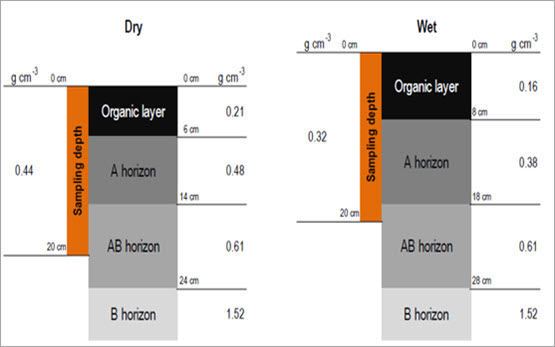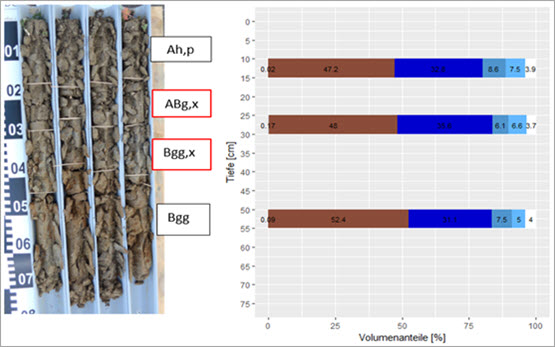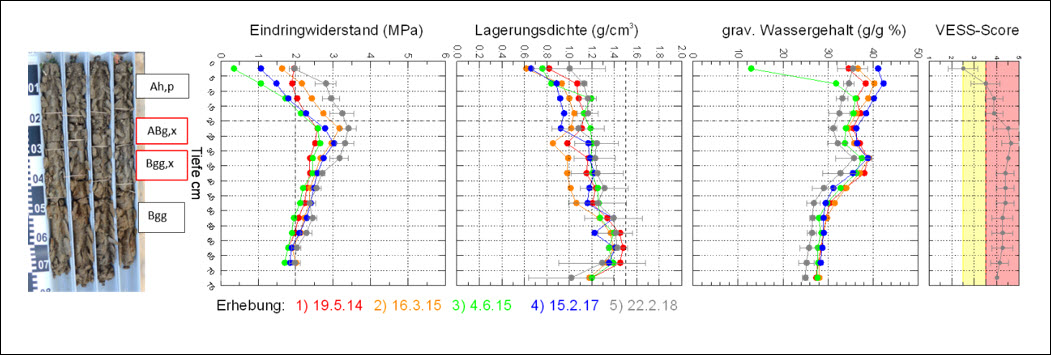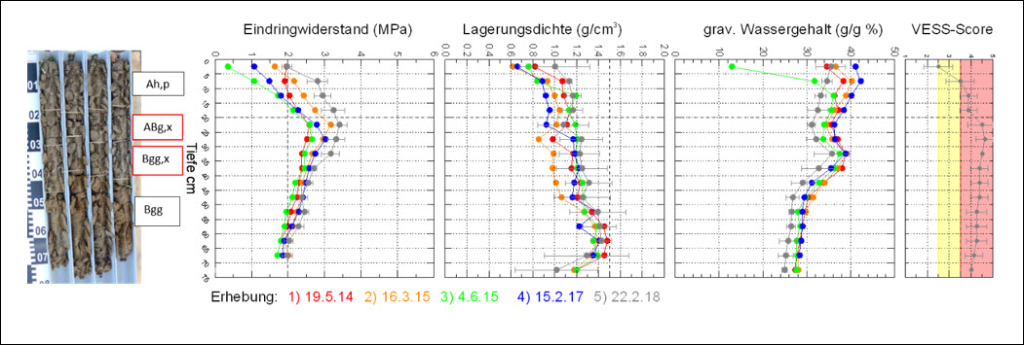The physical characteristics of soil play a central role for soil functions. For example, the porosity and pore continuity influence the soil’s ability to absorb and store water (regulatory function). Aeration and water balance of a soil also influence the ability to produce food or feed (production function). For this reason, we also record accompanying physical parameters at all our sites and the compaction status at selected sites.
Accompanying physical parameters
The conditions during soil sampling influences the properties of the soil sample: Soil is a dynamic body that can swell or shrink dependent on its water content. If the soil is dry, one reaches deeper layers with the prescribed sample collection depth of 20 cm. The opposite of this is true when the soil is moist, the horizons are swollen and thicker due to the increased water content (Fig. 1). For a fixed sampling depth of 0 to 20 cm, this means that dependent on water content different amounts of the various soil horizons are sampled. For soil parameters with pronounced depth gradients, such as organic carbon or lead, different concentrations are measured dependent on soil moisture.

The so-called auxiliary physical parameters apparent density of fine earth, bulk density, water content and skeleton content are determined at each sampling on the basis of volume samples from 0 to 20 cm. This allows us to assess the comparability of samplings from different time points. Furthermore, the apparent density also allows weight-related concentrations to be converted to soil volumes, which in turn allows the observation of stocks (e.g. g carbon per m2) and mass flows. If auxiliary physical parameters are missing, they can be estimated for soil samples of 0 to 20 cm from the pedotransfer functions derived from NABO.
Compaction
The driving on soils and the soil cultivation physically impact soils and thus compact their fragile structure. Along with the destruction of soil aggregates, the cavity system with its pores is damaged. Their volume shrinks and their continuity decreases, impeding aeration, infiltration capacity and water retention capacity. As a result, the biological activity in the soil declines. Physical damage below the standard plough depth has especially severe consequences. The compaction of subsoil impacts the functionality of the ecosystem in the long term. Neither natural processes nor technical measures can reverse these adverse effects in a reasonable timeframe.
Since 2015, we have been investigating the compaction status of 40 NABO sites as part of the regular 5-year sampling cycle. The aim of these investigations is to locate possible compaction zones and to detect long-term changes in compaction (location and extent). For this purpose, we measure the penetration resistance to a depth of 70 cm with a PANDA probe. Since the soil water content strongly influences the measured resistance, we simultaneously determine the accompanying physical parameters water content and bulk density based on layer samples. Since 2018, we have also been visually assessing the microstructure on the 5 cm layer samples (Score VESS). This allows us to describe the microstructure quality in a profile-wide manner and to investigate a relationship to the other compaction parameters.
In order to estimate the influence of the water content on the penetration resistance of different soil types, we have been collecting a series of measurements with different water contents at selected sites since 2014 (Fig. 2). The aim is to derive correction possibilities for the penetration resistance at different water contents.
Water storage capacity, water and air flow
Since 2018, we have been investigating additional physical properties from cylinder samples at selected NABO locations. From three horizons (topsoil, anthropogenically compacted horizon and non-compacted subsoil), we determine the parameters pore distribution, air permeability and gas diffusion.

Our aim is to document the water storage capacity and the water and airflow of the different soil types and to estimate possible effects of soil compaction on these properties.
Contact
Publications
Last modification 06.08.2021







